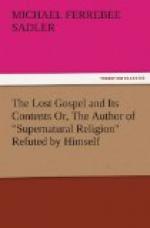Now any unprejudiced reader, on examining this account, would instantly say that Justin had derived every word of it from the Gospels of St. Matthew and St. Luke, but that, instead of quoting the exact words of either Evangelist, he would say that he (Justin) “reproduced” them. He reproduced the narrative of the Nativity as it is found in each of these two Gospels. He first reproduces the narrative in St. Matthew in somewhat more colloquial phrase than the Evangelist used, interspersing with it remarks of his own; and in order to account for the Birth of Christ in Bethlehem he brings in from St. Luke the matter of the census, (not with historical accuracy but) sufficiently to show that he was acquainted with the beginning of Luke ii.; and in order to account for the fact that Christ was not born in the inn, but in a more sordid place (whether stable or cave matters not, for if it was a cave it was a cave used as a stable, for there was a “manger” in it), he reproduces Luke ii. 6-7.
Justin then, in a single consecutive narrative, expressed much in his own words, gives the whole account, so far as it was a fulfilment of prophecy, made up from two narratives which have come down to us in the Gospels of St. Matthew and St. Luke, and in these only. It would have been absurd for him to have done otherwise, as he might have done if he had anticipated the carpings of nineteenth century critics, and assumed that Trypho, an unconverted Jew, had a New Testament in his hand with which he was so familiar that he could be referred to first one narrative and then the other, in order to test the correctness of Justin’s quotations.
Against all this the author of “Supernatural Religion” brings forward a number of trifling disagreements as proofs that Justin need not have quoted one of the Evangelists—probably did not—indeed, may not have ever seen our synoptics, or heard of their existence. But the reader will observe that he has given the same history as we find in the two synoptics which have given an account of the Nativity, and he apparently knew of no other account of the matter.




